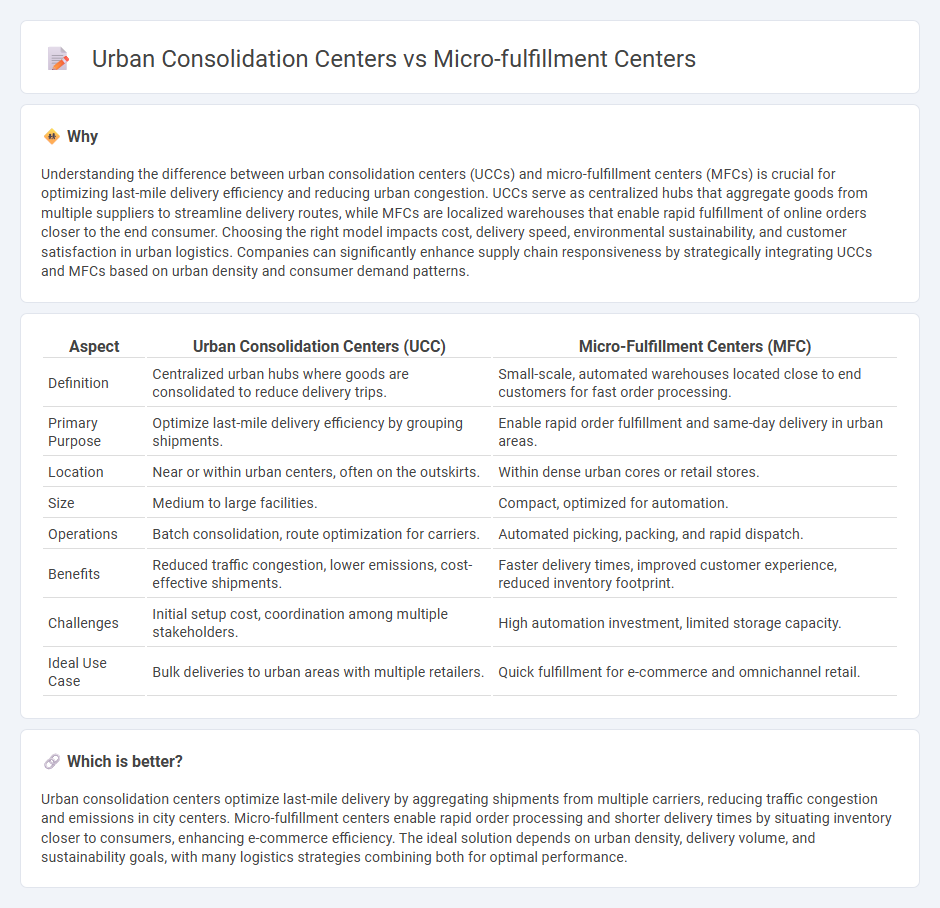
Urban consolidation centers streamline last-mile delivery by aggregating shipments to reduce traffic congestion and emissions in city centers. Micro-fulfillment centers utilize automated, small-scale warehouses located near or within urban areas to enable rapid order processing and shorter delivery times. Discover how these innovative logistics solutions are transforming urban supply chains and boosting efficiency.
Why it is important
Understanding the difference between urban consolidation centers (UCCs) and micro-fulfillment centers (MFCs) is crucial for optimizing last-mile delivery efficiency and reducing urban congestion. UCCs serve as centralized hubs that aggregate goods from multiple suppliers to streamline delivery routes, while MFCs are localized warehouses that enable rapid fulfillment of online orders closer to the end consumer. Choosing the right model impacts cost, delivery speed, environmental sustainability, and customer satisfaction in urban logistics. Companies can significantly enhance supply chain responsiveness by strategically integrating UCCs and MFCs based on urban density and consumer demand patterns.
Comparison Table
| Aspect | Urban Consolidation Centers (UCC) | Micro-Fulfillment Centers (MFC) |
|---|---|---|
| Definition | Centralized urban hubs where goods are consolidated to reduce delivery trips. | Small-scale, automated warehouses located close to end customers for fast order processing. |
| Primary Purpose | Optimize last-mile delivery efficiency by grouping shipments. | Enable rapid order fulfillment and same-day delivery in urban areas. |
| Location | Near or within urban centers, often on the outskirts. | Within dense urban cores or retail stores. |
| Size | Medium to large facilities. | Compact, optimized for automation. |
| Operations | Batch consolidation, route optimization for carriers. | Automated picking, packing, and rapid dispatch. |
| Benefits | Reduced traffic congestion, lower emissions, cost-effective shipments. | Faster delivery times, improved customer experience, reduced inventory footprint. |
| Challenges | Initial setup cost, coordination among multiple stakeholders. | High automation investment, limited storage capacity. |
| Ideal Use Case | Bulk deliveries to urban areas with multiple retailers. | Quick fulfillment for e-commerce and omnichannel retail. |
Which is better?
Urban consolidation centers optimize last-mile delivery by aggregating shipments from multiple carriers, reducing traffic congestion and emissions in city centers. Micro-fulfillment centers enable rapid order processing and shorter delivery times by situating inventory closer to consumers, enhancing e-commerce efficiency. The ideal solution depends on urban density, delivery volume, and sustainability goals, with many logistics strategies combining both for optimal performance.
Connection
Urban consolidation centers (UCCs) and micro-fulfillment centers (MFCs) enhance last-mile logistics efficiency by streamlining inventory management and delivery processes within dense metropolitan areas. UCCs aggregate goods from multiple suppliers to reduce delivery trips, while MFCs, equipped with automation technologies, rapidly fulfill customer orders close to end-users. Their integration supports reduced urban congestion, lower carbon emissions, and faster delivery times, optimizing urban supply chain operations.
Key Terms
Last-mile delivery
Micro-fulfillment centers streamline last-mile delivery by leveraging automated storage and retrieval systems within urban areas, reducing delivery times and costs through proximity to customers. Urban consolidation centers, positioned near city outskirts, aggregate goods from multiple suppliers to optimize load capacity and decrease inner-city traffic congestion and emissions. Explore how integrating these solutions can revolutionize urban logistics and enhance delivery efficiency.
Inventory management
Micro-fulfillment centers optimize inventory management by using automated storage and retrieval systems to handle high SKU density within limited urban spaces, enabling rapid order fulfillment. Urban consolidation centers focus on aggregating deliveries from multiple suppliers to reduce last-mile freight trips, emphasizing inventory staging rather than extensive storage. Explore how these models can transform your supply chain efficiency.
Order consolidation
Micro-fulfillment centers (MFCs) streamline order consolidation by using automated systems to pick and pack small orders rapidly within urban areas, reducing last-mile delivery times. Urban consolidation centers (UCCs) serve as centralized hubs where goods from multiple suppliers are combined into fewer shipments, optimizing urban freight flows and minimizing congestion. Explore how these solutions enhance order consolidation to improve urban logistics efficiency.
Source and External Links
Micro-Fulfilment: In-Depth Guide + 7 Real Examples - Dropoff - Micro-fulfillment centers are small facilities that enable rapid same-day order fulfillment by holding inventory close to consumers, with examples like Gopuff and ShopRite demonstrating their operational efficiency and local community support.
What Are Micro Fulfillment Centers? - City National Bank - Micro-fulfillment centers (MFCs) are typically 3,000 to 10,000 square feet warehouses designed to store a limited assortment of popular products for fast shipping, often located in urban or regional centers, using automation or human labor to fulfill orders quickly.
Walgreens to increase stores serviced by micro-fulfillment centers - Walgreens is expanding its micro-fulfillment network to nearly 6,000 stores serviced by 11 automated centers, improving operational efficiency and cost effectiveness to accelerate prescription delivery and other fulfillment services.
 dowidth.com
dowidth.com